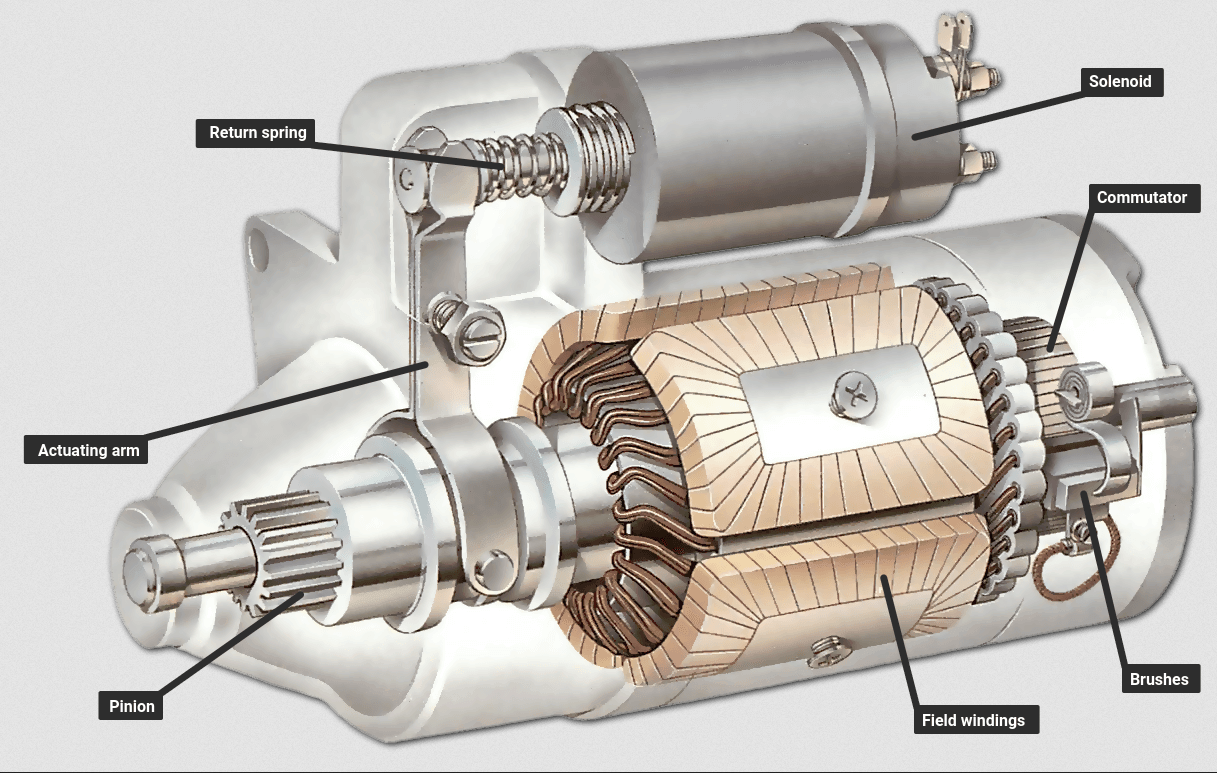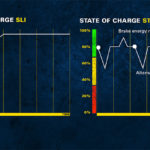The previous part of the article provided the context and rationale for stop/start operation in cars with internal combustion engines. This part will look at its impact on the starter motor itself.
Q: Which vehicles need a starter motor and why?
A: Electric motors do not need a starter, as they self-start and rotate when power is applied; thus, all-electric vehicles do not have one. (Ironically, a very different type of motive power used in early motor vehicles – the steam engine –also does not need an external starter but instead begins its up-and-down piston action as soon as steam pressure is allowed to enter the cylinder.)
In very sharp contrast, internal combustion engines, whether gasoline, diesel, or other, do need an enteral “push” to get them started, so the air/fuel mix can be accepted into the cylinder (whether from a carburetor or fuel injection), ignited, cause an internal explosion, and then motivate the piston to its up/down action within the cylinder.
Q: How were cars started before electric starters?
A: Before the electric starter, the driver had to literally “crank” the engine by rapidly and forcefully turning a large crank inserted in the engine from the car front. It took considerable torque to get the engine to turn over, and many drivers simply could not do it; further, the amount of effort required increased as engines got larger. It is also dangerous, and the kickback from a crank handle could break an arm or more. If the engine was “balky” – as early ones were – the car would not start, and the car was said to be “cranky” (this is believed to be the source of that common English designation for someone’s “crabby” or “grouchy” demeanor).
Q: When were starters for cars developed and incorporated into vehicles?
A: Early attempts at replacing the need for the crank included springs, pneumatic and hydraulic assistance, and even gunpowder in cartridges. Charles F. Kettering developed the electric starter in the 1910 period and worked closely with Cadillac founder Henry M. Leland (who had already pioneered electric lights and electric ignition on his cars) to incorporate the device into the 1912 model Cadillac – a major innovation which made driving possible for people of all strengths and sizes. Within the decade, nearly all cars incorporated the electric starter. The basic operation of the electric-motor stater is surprisingly similar to the first design. Still, the design has been improved in countless small and large ways, both visible and invisible.
Q: How does the electric starter for internal combustion engines work?
In simplified form, there’s a “flexplate” or flywheel with a ring gear around the edge and attached to the end of the engine crankshaft (Figure 1). On the starter, there’s a gear designed to fit into the grooves of the ring gear (the starter gear is called a pinion gear).

When the ignition switch is turned, or the start button pushed, the starter motor is energized, and the electromagnet inside the body engages. This pushes out a rod to which the pinion gear is attached. The gear meets the flywheel, and the starter turns. This spins the engine over, sucking in air (as well as fuel). Simultaneously, electricity is sent through the spark plug wires to the plugs, igniting the fuel in the combustion chamber.
As the engine turns over, the starter disengages, and the electromagnet stops. The rod retracts into the starter once more, taking the pinion gear out of contact with the flywheel and preventing damage. If the pinion gear remained in contact with the flywheel, it’s possible that the engine would spin the starter too fast, causing damage to it.
Q: How does the starter motor of a stop/start system differ from a non-stop/start system?
The stop/start technology starter motor looks, at first glance, to be the same but more powerful, faster-acting, and more robust. Further, it is often powered by a higher-voltage electrical system with bigger storage batteries.
Some starters are called ‘TS’ for ‘tandem solenoid’ and designed to work more smoothly with scenarios where the engine is about to stop. The driver accelerates again, which occurs when a driver has decided to stop but then decides to keep going, such as when the traffic moves along unexpectedly (more on this in a subsequent part of this article). At that critical moment, the engine management might be ‘committed’ to stopping, but it is still spinning. Therefore, to avoid crunching, one solenoid fires up the starter motor to synchronize its speed with the engine before the second smoothly engages the gear. It’s very much a tricky situation – one of many associated with stop/start.
The next part of this article will look at the impact of stop/start operation on the car’s battery and electrical subsystem.
Related EE World Content
Are power systems up to the task of running self-driving cars?
Power modules lessen the load on internal combustion engines
Today in Engineering History: Internal Combustion Engine Patented
Hybrid EVs come to touring car racing
How bidirectional converters speed the design of dual-battery automotive systems
External References
There’s a lot of information available about stop/start, as there is almost anything related to cars: it’s a big industry that affects just about everyone in one way or another. Perhaps because stop/start is relatively new, contrary to tradition, and has many technical and driver-related issues, the content of these sites ranges from personal opinion to technical discussion, to in-depth technical analysis. These are the useful sites and sources I reviewed for this article:
- Green Car Reports, “Don’t start-stop systems wear out your car’s starter?”
- Autocar, “Stop-start systems: is there a long-term impact on my car’s engine?”
- CarPro USA, “Understanding Stop/start Systems”
- Driving, “How It Works: Starters and automatic start-stop technology”
- Varta (Clarios), “Reasons why the start-stop system does not work”
- Varta (Clarios), “What is automatic start-stop and how does it work?”
- Varta (Clarios), “Why do I need a special battery for the automatic start-stop system?”
- Varta (Clarios), “Start-Stop”
- The Jag Wrangler, “SmartStartStop”
- The Truth About Cars, “The Problem With Start-Stop Systems”
- Best Ride, “Does Auto-Stop/Start Technology Wear Out Engine Components?”
- Practical Motoring, “Myth-busting: Does stop-start damage your engine?”
- NAPA, “Stop-Start Technology — Pros and Cons”
- Idle Smart, “Pros and Cons of Automatic Engine Stop/start Solutions”
- How Stuff Works, “Love It or Hate It: Stop-start Technology Is Here to Stay”
- Wikipedia, “Start-stop system”
- STMicroelectronics, “48V Start-Stop System”
- Daimler, “Under the microscope: ECO stop/start: Sophisticated technology gives the highest levels of efficiency”
- Argonne National Laboratory, “Start and Restart Effects on Modern Vehicle Starting Components”
- Bosch, “Full power for stop/start”
- How a Car Works, “How the starting system works”
- Your Mechanic, “How Does a Starter Motor Work?”
- General Motors, “Cadillac’s Electric Self Starter Turns 100”
- Elreg Distributors, “The Evolution of the Starter Motor”
- PR Newswire, “ZMJ and CRCI to Acquire Bosch’s Starters and Generators Business”
- TechLink, “Enhanced Starter Motor Operation in Engine Stop/Start Systems”
JeepFan, “How Electronic Start Stop ESS Works on the Jeep Wrangler JL







This is what i was talking about how to the car engine works and everything. Thanks for the valuable information. Subscribed your blog.